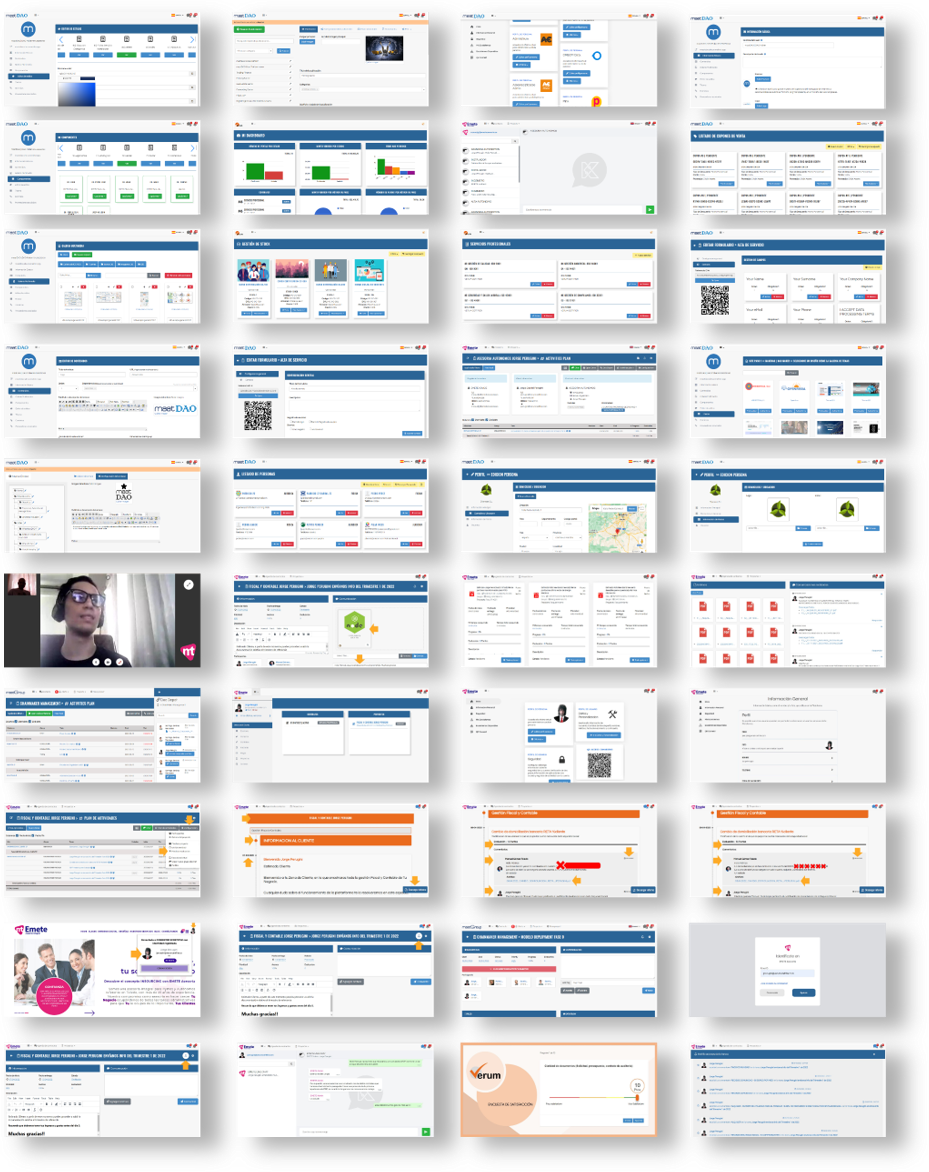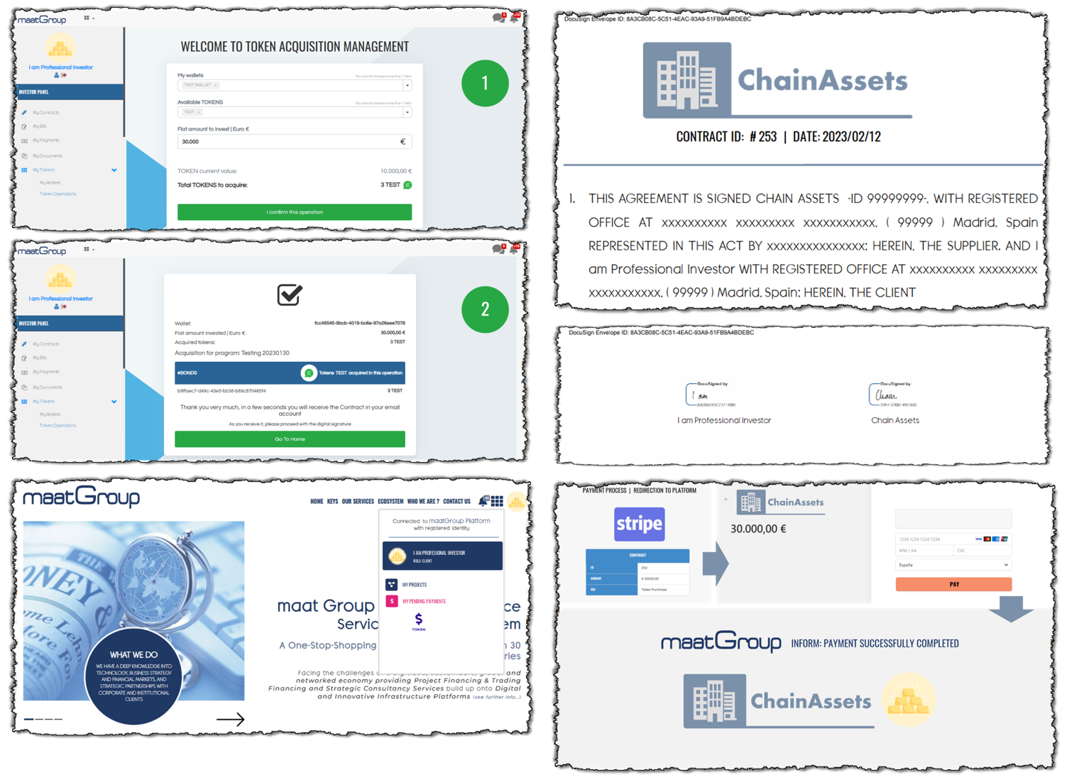maatDAO Core Platform

Elastic Cross Service by maatDAO
maatDAO Platform is an end-to-end Suite from which you can manage your entire Business Strategy, based on the secure Tokenization of your Assets
maatDAO Platform is able to designing, creating, deploying, configuring and managing the "state of the art" of any kind of DAO
maatDAO Platform provides a safe vehicle to any industry that protects both your wealth as the wealth of the Professional Investors to whom is aimed, in accordance with the regulation of the European Directive MIFIID2
maatDAO take advantages from the more advanced information and communication technologies to increase operational efficiency, share information and improve the quality services. Is a "state of the art" way of storing and sharing information in a safe and open virtual space of interconnected networks that allows direct interaction and collaboration
In this context, innumerable models have emerged, many of them of enormous value, although -in our opinion-, three have been the most outstanding paradigms in terms of enabling access to opportunities and that ultimately have allowed the coining of the concept "technological democratization”, since it has offered small companies those capacities that until before its appearance were only reserved for large organizations: CLOUD COMPUTING, BLOCKCHAIN and FINTECH
maatDAO is inspired by this three hugh paradigms to become a Technological Platform based on participatory and collaborative Social Intelligence; presenting an agile, robust, highly usable and easy-to-operate environment: permanently attentive to the comfort of the end user.
This Model ensures the orchestrated provision of technological services, guaranteeing a controlled environment where all its components work in an integrated, harmonious, organized and safe way
All the layers that make up the maatDAO Model interact with each other and each of them has the mission of delivering services to the whole. Each of the layers is aimed to specific user profiles (End User, IT User, System Architect User) therefore, maatDAO provides the appropriate set of interfaces for each profile depending on the Layer in which it acts
maatDAO connects infrastructure components to enable the wider use of performance contracts and predictive maintenance schemes while at the same time drastically increasing the potential for improved asset exploitation through its tokenized representation
The Interoperability Management is one of the most prominent pillars in terms of enabling access to opportunities, promoting integration between information, communication and manufacturing systems; since standards management acquires a fundamental role in the creation and sharing of knowledge as the basis of integration, not only technological, but also in the modeling of business processes and organizational interaction.
Whoever does not have the able to share data, exchange information and knowledge or integrate with other sources, will see their competitive capacity inexorably reduced and will have to assume the risk of being definitively isolated.
Consequently, it is imperative that the Information and Management Systems that we manage have the able to obtain information from different sources through the interfaces that they publish, although it is even more significant that our Information and Management Systems structure the information so that it can be interpreted by third parties who need to connect with us in an organized and secure way
The Interoperability concept also reaches internal management, so that maatDAO guarantees the interoperability of all its internal services, structured through big trunk-type entities, from which the different (and innumerable) functional components of enormous wealth offered by the Platform are integrated

In this context, maatDAO has an Identity Management supported by Industry standards, capable of managing the Authentication, Authorization and Accounting process in a transparent manner, managing the request / token / secure session rules until the relationship is fully satisfied. of trust before allowing the requesting party to access the services; determining their ability to consume resources, repositories and applications, based on the identification of profiles, roles, attributions and rules
Likewise, it manages the SINGLE SIGN ON concept, guaranteeing that access to all services is resolved without having to identify yourself again each time a different service is required to be consumed; offering the possibility of relying on other reference accounts in which the user has previously registered: such as Google
The Platform allows you to create, design and develop Presentation Layers; providing tools that enable the end-end configuration of the general structure and the particular structures to adapt them to the Sector to which it is addressed. Administrator User will be able to customize their corporate identity, domain and subdomain management, provision and automatic management of SSL certificates, language management, email manager, notification templates, user administration, cache management, session management, file management, interoperability administration with external agents... among other functions
The treatment of the content is absolutely dynamic and reusable. The user will be able to define the behavior, the source of information that will be presented, the elements where the content will be presented and the regions that will be occupied within the framework of each element. It is articulated on the basis of four major concepts, with the ability to relate to each other: PUBLICATION MANAGEMENT, CATEGORY MANAGEMENT, LINK MANAGEMENT and MULTIMEDIA MANAGEMENT. In this way, the user can create any type of presentation and present it according to their preferences for appearance, styles, groupings, relationships or illustrations.

The business logic will reside in the component. Through the Configurator of each component, the ADMIN user will define the behavior, the source of information that will be presented and the structure in which the information will be presented. Components or widgets are encapsulated, generic and reusable code instances that resolve a specific functionality and can occupy any region of any structure. All of this can be configured by the ADMIN user.
The decoupling will be absolute and any publication may be presented within the framework of any structure, located in any area and published under any type of grouping.
The ADMIN user configures the scope policies and behavior rules. Then, it will decide to what extent it will allow END users freedom to define the business models that they will apply to their own services. Consequently, the ADMIN user will define the degrees of freedom that your Organization will offer to its suppliers and consumers; and you can do it by applying policies that range from very restrictive options to absolute freedom
The maatDAO components present a functional richness of maximum depth. All of them are oriented to work in an integrated and harmonious way, which, added to their reusable nature, end up forming a framework able of modeling any Business of any Sector of Activity

DAO Management and Digital Assets Tokenization
A Decentralized Autonomous Organization (DAO) is an organization run with smart contracts on a public blockchain. Think of a DAO as an organization that uses smart contracts to facilitate and enforce decisions made by its members. At its core, a DAO is a piece of software on the blockchain that manages permissions to other contracts and actors.
A DAO is self-governing in that it is managed directly by its members, as individuals or holders of assets, on the actions the organization takes. These actions occur onchain, meaning they are executed and recorded on the blockchain. Some actions include managing funds, holding votes, or changing the DAO's governance parameters itself.
To get things done, humans have always organized themselves into groups, tribes, squads, crews, teams, companies, and other units of collective action. DAOs are no different. DAOs have ranged from groups of developers, investment clubs, advocacy groups, lean product teams, charities, digital public goods infrastructure, and more. The possibilities are infinite.
The main difference between DAOs and traditional organizations is that instead of enabling coordination by trusting central intermediaries to enforce decisions, DAOs can remove this need for trust by making and enforcing decisions on the blockchain.
Using blockchain as infrastructure grants DAOs unique properties when compared to traditional organizations, including:
- Trustless execution of collective decisions: Smart contracts automatically execute the results of collective decisions, such as those held through votes. The results of this decision-making process are recorded onchain, are not alterable and are reliably executed by smart contracts.
- Crypto-economic incentives create alignment between actors in the organization: DAO technology allows you to program incentives directly into the governance of your organization through smart contracts.
- Governance experimentation at the speed of software: DAOs can experiment more freely than traditional large-scale organizations. Internet-native organizations can be more agile, creative, and dynamic, rather than slow and cumbersome (or potentially violent) like governance in nation states.
- Blockchain as a source of truth: The blockchain is a distributed ledger that anyone can write in but no one can change the entries of anyone else. So, this means all transactions the DAO makes can be universally verifiable by anyone. This includes onchain votes, asset transfers, token mints, and more.
- Transparent and open by default: DAOs operate open by default because the blockchain is transparent. Everything from treasury holdings to payment flows is visible to everyone globally. However, privacy-preserving technology, like Zero Knowledge Proofs, could be implemented to make certain aspects of DAO operations private.
The Platform offers all the tools for the users to manage the creation, launching, governance, administration and exploitation of their DAO

In addition, the Platform offers different Value Models that will allow managing any need for participation, visibility and the ability to optimize the marketing model of the Tokenized Asset. We are referring to the WRAP, BRIDGE and SWAP Models, surrounded by all the facilities to make it possible to manage this type of highly complex model.

Conceptually, the Platform allows the creation and cataloging of models so that they can be reused later. In addition, it will allow you to manage a Transactional Dashboard for each model and an associated Queue Manager to be able to carry out in-depth monitoring and tracing of all related operations in the different chains where they have acted.
From the functional point of view at Business Layer, the Tokenization Strategy suppported on maatDAO Platform manages a highly elastic, resilient and customizable model; meeting the needs of all the actors involved in each process and from different business perspectives, which makes it highly adaptable to any Business Sector
The Admin User Role will have a full functional toolset to carry out the management and administration of their hybrid digital assets with maximum guarantees
The Investment process is not only secured by the underlying infrastructure, but also, adds a digital signature and a controlled payment procedure that will allow the Investors to manage their operations with full guarantee
The Investor may manage as many Wallets as required. By accessing each of his Wallets, the Investor will have a consolidated view of his Tokens deposited, with their corresponding particular balance.
Likewise, the Investor will also have available a historical analytical view drill&down kind, where you can analyze the composition of the balance of the selected Token
The Platform has a completely dedicated ERP that offers detailed and related registration of all movements operated: Contract, Billing, Payments and Document Manager
The Platform allows TO MANAGE THE KYC MODEL in a simple and configurable way. It refers to the compliance and verification procedure that the Organization wishes to carry out to know and validate its users before initiating relationships with them and thus mitigate the possibility of establishing links with natural or legal persons that carry out activities that do not comply with ethical, moral or legal values










